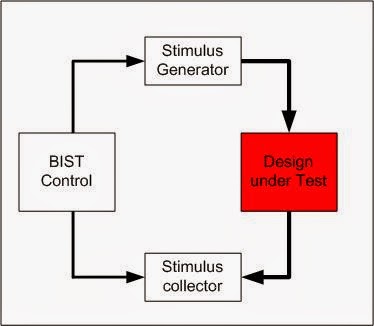one of the method is , using LFSR, LFSR generates random stimulus and it is expected that chip is in its normal functional mode. with the configuration, with LFSR , one can validate the data path in system or in IP.
What is the motivation for BIST ?
-> cost-efficient testing
-> stuck-at-fault model
-> cost of ATE (Automatic Test Equipment)
Types of BIST
-> on-line BIST
-> Concurrent on-line BIST
Occurs simultaneously with normal functional operation , normally coding techniques or duplication and comparison are used.
-> Non-concurrent on-line BIST
Carried out while in idle state , by executing software or firmware routines .
-> off-line BIST
System is not in its normal functional mode.
-> Functional off-line BIST
It is based on a functional description of the circuit under test and uses functional high level fault models.
-> Structural off-line BIST
Execution based on the structure of the circuit under test and used structural fault models.
Example - Stuck-At-Fault (SAF) - cell stuck at constant value
Transition Fault (TF) - a cell which fails to go from 0->1 or 1->0 transition
Coupling Fault (CF) - write operation to one cell changes the contents of a second cell
General Architecture of BIST
Below is typical architecture of BIST testing , bist generator and bist collector would be inside DUT or outside DUT , depends on the BIST type.
LFSR Based Testing :
LFSR : Linear Feedback Shift Register , hardware that generates psedo-random pattern for CUT (circuit under test)
BILBO : Built-In logic block observer , extra hardware need to convert flip-flop into scan chain in test mode.
Exhaustive Testing : Apply all possible 2 (power of) n pattern to a circuit with n inputs , this will take more ATE time.
Pseudo-exhaustive testing: Break circuit into small , overlapping blocks and test it.
Psudo Random test generation :
PRBS is basically a polynomial having a standard definition, for exam - PRBS7, PRBS8, PRBS10, PRBS 31 ..
higher the number of PRBS, pattern will be more random and possibilities to hit a expected pattern in pattern generation will increased.
below is one example of implementation of polynomial, if you are more interested to go in more deep, send a email to me.
Ref -
http://en.wikipedia.org/wiki/Built-in_self-test
http://www.asic.co.in/ppt/BIST2.pdf


No comments:
Post a Comment